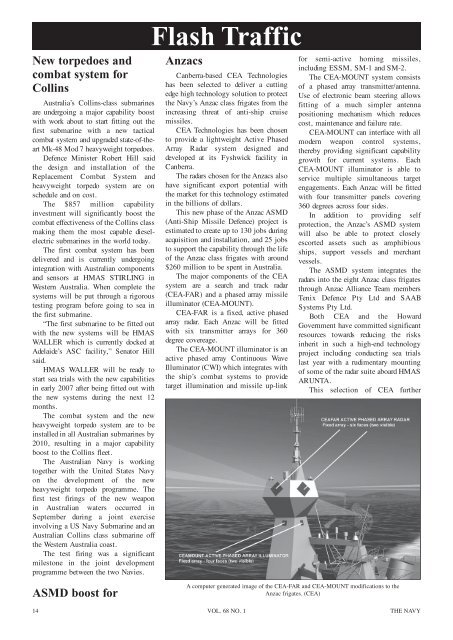The Navy Vol_68_No_1 Jan 2006 - Navy League of Australia
The Navy Vol_68_No_1 Jan 2006 - Navy League of Australia
The Navy Vol_68_No_1 Jan 2006 - Navy League of Australia
Create successful ePaper yourself
Turn your PDF publications into a flip-book with our unique Google optimized e-Paper software.
New torpedoes and<br />
combat system for<br />
Collins<br />
<strong>Australia</strong>’s Collins-class submarines<br />
are undergoing a major capability boost<br />
with work about to start fitting out the<br />
first submarine with a new tactical<br />
combat system and upgraded state-<strong>of</strong>-theart<br />
Mk-48 Mod 7 heavyweight torpedoes.<br />
Defence Minister Robert Hill said<br />
the design and installation <strong>of</strong> the<br />
Replacement Combat System and<br />
heavyweight torpedo system are on<br />
schedule and on cost.<br />
<strong>The</strong> $857 million capability<br />
investment will significantly boost the<br />
combat effectiveness <strong>of</strong> the Collins class<br />
making them the most capable dieselelectric<br />
submarines in the world today.<br />
<strong>The</strong> first combat system has been<br />
delivered and is currently undergoing<br />
integration with <strong>Australia</strong>n components<br />
and sensors at HMAS STIRLING in<br />
Western <strong>Australia</strong>. When complete the<br />
systems will be put through a rigorous<br />
testing program before going to sea in<br />
the first submarine.<br />
“<strong>The</strong> first submarine to be fitted out<br />
with the new systems will be HMAS<br />
WALLER which is currently docked at<br />
Adelaide’s ASC facility,” Senator Hill<br />
said.<br />
HMAS WALLER will be ready to<br />
start sea trials with the new capabilities<br />
in early 2007 after being fitted out with<br />
the new systems during the next 12<br />
months.<br />
<strong>The</strong> combat system and the new<br />
heavyweight torpedo system are to be<br />
installed in all <strong>Australia</strong>n submarines by<br />
2010, resulting in a major capability<br />
boost to the Collins fleet.<br />
<strong>The</strong> <strong>Australia</strong>n <strong>Navy</strong> is working<br />
together with the United States <strong>Navy</strong><br />
on the development <strong>of</strong> the new<br />
heavyweight torpedo programme. <strong>The</strong><br />
first test firings <strong>of</strong> the new weapon<br />
in <strong>Australia</strong>n waters occurred in<br />
September during a joint exercise<br />
involving a US <strong>Navy</strong> Submarine and an<br />
<strong>Australia</strong>n Collins class submarine <strong>of</strong>f<br />
the Western <strong>Australia</strong> coast.<br />
<strong>The</strong> test firing was a significant<br />
milestone in the joint development<br />
programme between the two Navies.<br />
Flash Traffic<br />
Anzacs<br />
Canberra-based CEA Technologies<br />
has been selected to deliver a cutting<br />
edge high technology solution to protect<br />
the <strong>Navy</strong>’s Anzac class frigates from the<br />
increasing threat <strong>of</strong> anti-ship cruise<br />
missiles.<br />
CEA Technologies has been chosen<br />
to provide a lightweight Active Phased<br />
Array Radar system designed and<br />
developed at its Fyshwick facility in<br />
Canberra.<br />
<strong>The</strong> radars chosen for the Anzacs also<br />
have significant export potential with<br />
the market for this technology estimated<br />
in the billions <strong>of</strong> dollars.<br />
This new phase <strong>of</strong> the Anzac ASMD<br />
(Anti-Ship Missile Defence) project is<br />
estimated to create up to 130 jobs during<br />
acquisition and installation, and 25 jobs<br />
to support the capability through the life<br />
<strong>of</strong> the Anzac class frigates with around<br />
$260 million to be spent in <strong>Australia</strong>.<br />
<strong>The</strong> major components <strong>of</strong> the CEA<br />
system are a search and track radar<br />
(CEA-FAR) and a phased array missile<br />
illuminator (CEA-MOUNT).<br />
CEA-FAR is a fixed, active phased<br />
array radar. Each Anzac will be fitted<br />
with six transmitter arrays for 360<br />
degree covereage.<br />
<strong>The</strong> CEA-MOUNT illuminator is an<br />
active phased array Continuous Wave<br />
Illuminator (CWI) which integrates with<br />
the ship’s combat systems to provide<br />
target illumination and missile up-link<br />
for semi-active homing missiles,<br />
including ESSM, SM-1 and SM-2.<br />
<strong>The</strong> CEA-MOUNT system consists<br />
<strong>of</strong> a phased array transmitter/antenna.<br />
Use <strong>of</strong> electronic beam steering allows<br />
fitting <strong>of</strong> a much simpler antenna<br />
positioning mechanism which reduces<br />
cost, maintenance and failure rate.<br />
CEA-MOUNT can interface with all<br />
modern weapon control systems,<br />
thereby providing significant capability<br />
growth for current systems. Each<br />
CEA-MOUNT illuminator is able to<br />
service multiple simultaneous target<br />
engagements. Each Anzac will be fitted<br />
with four transmitter panels covering<br />
360 degrees across four sides.<br />
In addition to providing self<br />
protection, the Anzac’s ASMD system<br />
will also be able to protect closely<br />
escorted assets such as amphibious<br />
ships, support vessels and merchant<br />
vessels.<br />
<strong>The</strong> ASMD system integrates the<br />
radars into the eight Anzac class frigates<br />
through Anzac Alliance Team members<br />
Tenix Defence Pty Ltd and SAAB<br />
Systems Pty Ltd.<br />
Both CEA and the Howard<br />
Government have committed significant<br />
resources towards reducing the risks<br />
inherit in such a high-end technology<br />
project including conducting sea trials<br />
last year with a rudimentary mounting<br />
<strong>of</strong> some <strong>of</strong> the radar suite aboard HMAS<br />
ARUNTA.<br />
This selection <strong>of</strong> CEA further<br />
ASMD boost for<br />
A computer generated image <strong>of</strong> the CEA-FAR and CEA-MOUNT modifications to the<br />
Anzac frigates. (CEA)<br />
14 VOL. <strong>68</strong> NO. 1 THE NAVY

















